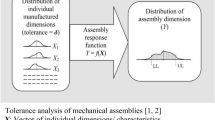Abstract
Random component variations have a significant influence on the quality of assembled products, and variation propagation control is one of the procedures used to improve product quality in the manufacturing assembly process. This paper considers straight-build assemblies composed of axi-symmetric components and proposes a novel variation propagation control method in which individual components are re-orientated on a stage-by-stage basis to optimise the table-axis error for the final component in the assembly. Mathematical modelling methods are developed to predict the statistical variations present in the complete assembly. Three straight-build assembly strategies are considered: (a) direct build, (b) best build and (c) worst build assembly. Analytical expressions are determined for the probability density function of the table-axis error for the final component in the assembly, and comparisons are made against Monte Carlo simulations for the purposes of validation. The results show that the proposed variation propagation control method offers good accuracy and efficiency, compared to the Monte Carlo simulations. The probability density functions are used to calculate the probability that the eccentricity will exceed a particular value and are useful for industrial applications and academic research in tolerance assignment and assembly process design. The proposed method is used to analyse the influence of different component tolerances on the build quality of an example originating in aero-engine sub-assembly.
Similar content being viewed by others
References
Mantripragada R, Whitney DE (1999) Modeling and controlling variation propagation in mechanical assemblies using state transition models. IEEE Trans Robot Autom 15:124–140
Lin CY, Huang WH, Jeng MC, Doong JL (1997) Study of an assembly tolerance allocation model based on Monte Carlo simulation. J Mater Process Technol 70:9–16
Thimm G, Britton G, Cheong FS (2001) Controlling tolerance stacks for efficient manufacturing. Int J Adv Manuf Technol 18:44–48
Forouraghi B (2002) Worst-case tolerance design and quality assurance via genetic algorithms. J Optim Theor Appl 13:251–268
Dantan JY, Qureshi AJ (2009) Worst-case and statistical tolerance analysis based on quantified constraint satisfaction problems and Monte Carlo simulation. Comput Aided Des 41:1–12
Spolts MF (1971) Design of machine elements. Prentice-Hall, Englewood Cliffs
Arron DD, Walter JM, Charles EW (1975) Machine design theory and practices. Macmillan, New York
He JR (1991) Estimating the distributions of manufactured dimensions with the beta probability density function. Int J Mach Tool Manuf 31:383–396
Nigam SD, Turner JU (1995) Review of statistical approaches to tolerance analysis. Comput Aided Des 27:6–15
Wu F, Dantan JY, Etienne A, Siadat A, Martin P (2009) Improved algorithm for tolerance allocation based on Monte Carlo simulation and discrete optimization. Comput Ind Eng 56:1402–1413
Toft N, Innocent GT, Gettinby G, Reid SW (2007) Assessing the convergence of Markov Chain Monte Carlo methods: an example from evaluation of diagnostic tests in absence of a gold standard. Prev Vet Med 79:244–256
Brooks SP, Gelman A (1998) Alternative methods for monitoring convergence of iterative simulations. J Comput Graph Stat 7:434–455
Mustafa YA (2007) A convergence criterion for the Monte Carlo estimates. Simulat Model Pract Theor 15:237–246
Jungemann C, Yamaguchi S, Goto H (1997) Convergence estimation for stationary ensemble Monte Carlo simulations. In: International conference on simulation of semiconductor processes and devices, 8–10 Sep 1997, Cambridge, MA, USA
Roy U, Li B (1998) Representation and interpretation of geometric tolerances for polyhedral objects-I. Form tolerances. Comput Aided Des 30:151–161
Roy U, Li B (1999) Representation and interpretation of geometric tolerances for polyhedral objects-II. Size, orientation and position tolerances. Comput Aided Des 31:273–285
Cai M, Yang JX, Wu ZT (2004) Mathematical model of cylindrical form tolerance. Journal of Zhejing University Science 5:890–895
Roy U, Liu CR, Woo TC (1991) Review of dimensioning and tolerancing, representation and processing. Comput Aided Des 23:466–483
Chen KZ, Feng XA, Lu QS (2002) Intelligent location-dimensioning of cylindrical surfaces in mechanical parts. Comput Aided Des 34:185–194
Whitney DE, Gilbert OL (1993) Representation of geometric variations using matrix transforms for statistical tolerance analysis in assemblies. In: Proceedings of the IEEE international conference on robotics and automation, Atlanta, GA, USA
Gunston B (1989) Rolls-Royce aero engines. Patrick Stephens, England
Whitney DE (2004) Mechanical assemblies. Oxford University Press, Oxford
Ding Y, Ceglarek D, Shi J (2000) Modeling and diagnosis of multistage manufacturing process: part I—state space model. In: Japan/USA symposium on flexible automation, Ann Arbor, MI
Li EE, Zhang HC (2001) Theoretical tolerance stackup analysis based on tolerance zone analysis. Int J Adv Manuf Technol 17:257–262
Pitman J (1993) Probability. Springer, New York
Author information
Authors and Affiliations
Corresponding author
Rights and permissions
About this article
Cite this article
Yang, Z., McWilliam, S., Popov, A.A. et al. A probabilistic approach to variation propagation control for straight build in mechanical assembly. Int J Adv Manuf Technol 64, 1029–1047 (2013). https://doi.org/10.1007/s00170-012-4071-x
Received:
Accepted:
Published:
Issue Date:
DOI: https://doi.org/10.1007/s00170-012-4071-x




